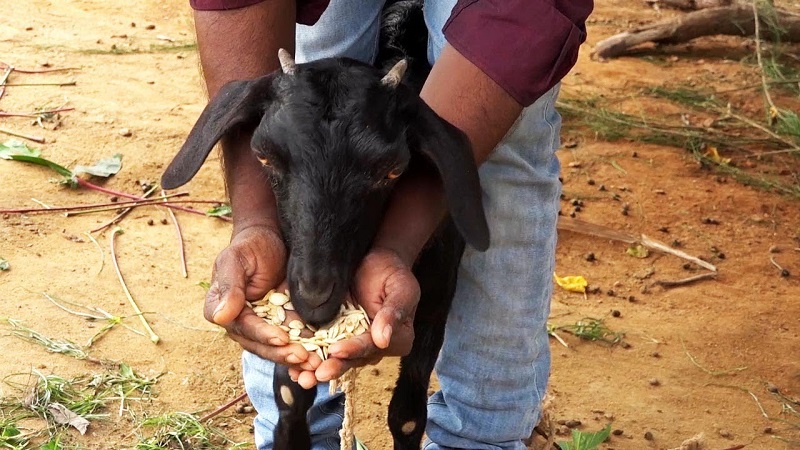

Sustainable parasite control usually refers to using alternatives that prevent resistance and minimize disease and production losses. Integrated parasite control combines traditional control with alternatives that do not depend exclusively on commercial anthelmintics. Visual indicators and other control measures are used to space chemical deworming and, thus, reduce resistance to commercial chemical compounds.
Five-Point Check indicators.
Nasal discharge: Even when it is not an indicator of nematode infection, the clear or purulent nasal discharge can be caused by Oestrusovis (a nasal parasite that has a fly as a vector). In addition to affecting the welfare of the animals, this infection can lead to immunosuppression and bacterial infections.
Ocular mucosa: Trained individuals can examine the eyes for signs of anemia.
Submandibular edema: This edema is a typical indicator of hypoproteinemia (low levels of protein in the blood) caused by GIN parasitism.
Body condition score (BCS): Body condition scoring is determined through observation and palpation of the back and sides of the animal.
Dag score: This scale measures the level of feces or diarrhea that accumulates on the rear end of animals.
Control at the Animal Level
Selection/culling: Select the most productive and parasite-resistant animals to keep in the herd, and cull those that require constant deworming or that permanently present high parasitic loads. Consider culling older animals, which develop teeth problems that affect their intake and compromise their immunity, making them more susceptible to nematodes.
Parasite-resistant breeds: Some sheep and goat breeds tend to be more tolerant to parasitism and, despite their parasite load, grow and reproduce properly.
Selective deworming or targeted selective treatment (TST): Use indicators to maintain refugia, deworming only those animals that require it. However, it is important to deworm animals that have compromised immunity (near weaning and peripartum), as well as new animals coming into the herd. Some indicators that can be used for TST or selective deworming are fecal analysis (1,000 EPG or above), FAMACHA score (4 and 5), and BCS score (lower than 3). Use any of these indicators or a combination of indicators.
Strategic supplementation: The relationship between adequate nutrition and an animal’s level of immunity to diseases is well known. Animals must receive a proper diet, especially during the growth and reproduction stages.
Alternative treatments: In goats, intraruminal copper particles, also called copper oxide wire particles (COWP) or copper needles, can be very effective. These can be applied as boluses every 3 months in adult and young goats. Farmer experience indicates that applications every 6 months are effective. COWP is effective only against H. contortus and T. circumcincta (in some cases). It can be used in sheep only on farms with copper-deficient soils.
Control at the Grazing Level
Adequate paddock rotation/rest periods: Allow enough time between groups of animals to prevent the larvae of the first group of animals from infecting the next group. An adequate resting period varies according to the weather and time of year. The life span of L3s in the grass is 21 days in tropical conditions and up to 6 or more months in temperate conditions.
Graze young/low-immunity animals in “clean” paddocks or pastures that have not been grazed previously by contaminated adult animals.
Avoid overgrazing: The life cycle of the GIN indicates that most L3s will be in the lowest part of the forages, near the soil and feces. When animals overgraze paddocks, they eat closer to the lower strata of the biomass, where there is a greater possibility of L3 contamination. Adjust stocking rate to paddock size to have enough biomass during the grazing period.
Use bioactive forages or plants containing secondary metabolites: These plant metabolites (tannins, saponins, lectins, and others) can have an anthelmintic effect on animals and decrease their parasitic loads.
Use multispecies paddocks: Animals can select an appropriate diet that allows them to better cover their nutritional requirements, and better-fed animals are more able to resist parasitism.
Use plants of different heights: This allows animals (mainly goats) to alternate grazing with browsing and avoid the most contaminated pasture strata.
Use mixed animal species grazing: Grazing sheep and goats with other species, such as cattle and horses, decreases the levels of infective larvae in grazing areas. After sheep or goats finish grazing, cattle or horses can act as “vacuum cleaners” of L3 larvae, lowering the chance of infection in small ruminants. Sheep and goats are top grazers that prefer the upper, immature parts of forages.
 Contact Jaguza Support
Contact Jaguza Support